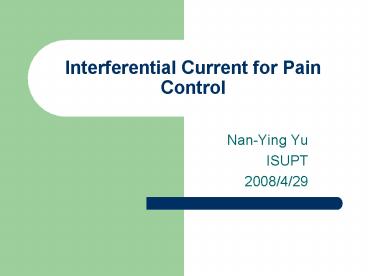Interferential Current for Pain Control - PowerPoint PPT Presentation
1 / 17
Title:
Interferential Current for Pain Control
Description:
One current is normally of fixed frequency, for example at 4000 Hz, and the ... in amplitude at a frequency equal to the difference between these two currents. ... – PowerPoint PPT presentation
Number of Views:897
Avg rating:3.0/5.0
Title: Interferential Current for Pain Control
1
Interferential Current for Pain Control
- Nan-Ying Yu
- ISUPT
- 2008/4/29
2
INTRODUCTION
- IFC has been reported to have the advantage of
reducing the skin resistance, and thus the
discomfort normally incurred by traditional
low-frequency currents, whilst still producing
low-frequency effects within the tissues.
3
PHYSICAL PRINCIPLES OF INTERFERENTIAL CURRENT
- IFC is produced by mixing two medium-frequency
currents that are slightly out of phase, either
by applying them so that they interfere within
tissues, or alternatively by mixing them within
the stimulator prior to application.
4
PHYSICAL PRINCIPLES OF INTERFERENTIAL CURRENT
- One current is normally of fixed frequency, for
example at 4000 Hz, and the other current is
adjustable, for example between 4000 and 4200 Hz. - Two currents summate or cancel each other out in
a predictable manner, producing the resultant
amplitude-modulated interferential current.
5
PHYSICAL PRINCIPLES OF INTERFERENTIAL CURRENT
- The frequency of the resultant current will be
equal to the mean of the two original currents,
and will vary in amplitude at a frequency equal
to the difference between these two currents. - This later frequency is known as the
amplitude-modulated frequency (AMF) or beat
frequency.
6
PHYSICAL PRINCIPLES OF INTERFERENTIAL CURRENT
7
TREATMENT PARAMETERS Amplitude-modulated
frequency
8
TREATMENT PARAMETERS Amplitude-modulated
frequency
- Low AMFs, elicit a beating or tapping
sensation, whilst higher AMFs elicit a buzzing
or tingling sensation. - AMF settings between 1 and 130 Hz have been
recommended for the treatment of pain.
9
TREATMENT PARAMETERS Frequency sweep
- A frequency sweep has been claimed
- to reduce adaptation
- to allow stimulation of a greater range of
excitable tissues
10
TREATMENT PARAMETERS Quadripolar/bipolar
application
- Quadripolar application ? Clover-leaf pattern
(frequency difference) - Bipolar application ? modulation is always 100
(full field) a easier alternative
11
Quadripolar application
12
TREATMENT PARAMETERS Suction versus plate
electrodes
- Flat carbon rubber electrode may be easier to
apply to peripheral limbs - Anatomic areas that are less accessible the
suction option may be advantageous
13
TREATMENT PARAMETERS
- Current Intensity
- Strong but comfortable stimulation
- Intensity should be slowly tuned up
- Treatment duration
- 10-20 minutes
14
THEORETICAL PAIN RELIFE MECHANISMS WITH IFC
- The pain gate theory
- Increased circulation
- Descending pain suppression
- Physiological block of nerve conduction
- Placebo
15
Evidence for theoretical analgesic mechanisms
with IC
16
Adverse effects
- Burns
- Increased pain
- General malaise
- Nausea
- Vomiting
- Dizziness/faintness
- Migraine/headache
- Neurological effects
17
Adverse effects
- Patients where disturbance of a thrombus, spread
of infection or cancerous cell, or haemorrhage
might result - Pacemakers
- The abdomen during pregnancy
- The chest wall in patients with cardiac problems.































